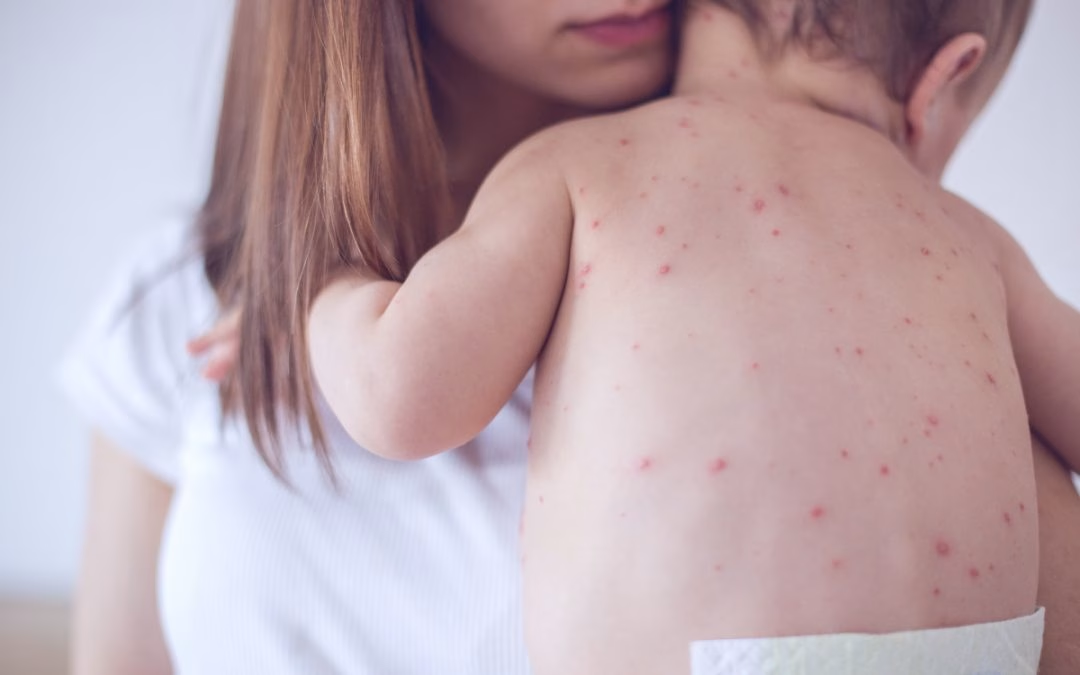
It’s a perfect spring afternoon at Blakeney Town Center, with families visiting local shops and grabbing yummy Peruvian cuisine from Pio Pio. But behind the warm community atmosphere, a serious health concern is growing: a measles outbreak is spreading across parts of the United States, including Texas, Oklahoma, and New Mexico. Health officials are working urgently to contain the virus, but it has left many wondering why is there a measles outbreak, and how can we protect ourselves and our families?
What is Measles?
Measles, also known as rubeola, is a highly contagious viral infection that primarily affects the respiratory system. It spreads easily through coughing, sneezing, or direct contact with an infected individual. You don’t even have to touch someone who is sick to catch measles the virus can linger in the air for up to two hours after an infected person has left the room.
Symptoms usually appear 7–14 days after exposure and may include:
- High fever (often exceeding 101°F)
- Cough, runny nose, and red eyes (known as the “3 C’s”)
- Tiny white spots inside the mouth called Koplik spots (appearing before the rash)
- Distinctive red rash that begins on the face and spreads downward about 3–5 days after the fever starts
Measles can cause severe complications, especially in young children, pregnant women, and people with weakened immune systems. These complications include pneumonia, brain swelling (encephalitis), and even death.
Why Are We Seeing a Measles Outbreak Now?
The main reason behind the recent measles outbreak is declining vaccination rates. Although measles was declared eliminated in the U.S. in 2000, growing vaccine hesitancy, misinformation, limited healthcare access, and disruptions caused by the COVID-19 pandemic have all led to lower immunization rates in many areas.
When a significant portion of the community remains unvaccinated, it opens the door for measles to spread rapidly. In fact, if one person contracts measles, up to 90% of nearby unvaccinated individuals can become infected.
Recent outbreaks in states like Texas, Oklahoma, and New Mexico have already surpassed the total number of U.S. cases recorded in all of 2024, and health officials warn that more cases could follow if vaccination coverage doesn’t improve. Even international travel can play a role, with linked cases emerging across borders.
How Does Measles Spread?
Measles is extremely contagious and spreads through:
- Airborne transmission: Breathing contaminated air
- Contact with infected surfaces: The virus can live on surfaces for several hours
- Direct contact: Touching an infected person or their belongings
Because measles is so contagious, even brief exposure in a shared space, like a museum, bounce house, or shopping center, can be enough to transmit the virus.
Prevention: How to Protect Yourself and Your Family
Fortunately, measles is highly preventable through vaccination and simple hygiene measures:
- Vaccination: The MMR vaccine (measles, mumps, and rubella) is about 97% effective at preventing measles when two doses are received. Children typically get their first dose at 12–15 months old and a second dose at 4–6 years.
- Isolation measures: If someone shows signs of measles, isolating them immediately helps prevent exposing others.
- Masking and hygiene: Wearing a mask, washing hands frequently, and disinfecting surfaces can lower the risk of spreading measles.
If you suspect that you or your child might have measles, it’s critical to:
- Contact an AFC healthcare provider or local health department immediately
- Isolate the patient at home until cleared by medical professionals
- Follow all medical advice, including staying home for at least 10 days
- Thoroughly clean and disinfect surfaces where the infected person has been
Other Illnesses That Mimic Measles
It’s important to note that some illnesses can look like measles, including:
- Rubella (German measles): Features a faster-spreading rash and swollen lymph nodes
- Roseola: Rash appears after a high fever breaks
- Scarlet fever: Notable for its rough, sandpaper-like rash and “strawberry tongue”
- Fifth disease (parvovirus B19): Causes a “slapped cheek” rash on the face
If you or your child experiences any of these symptoms, it’s always best to consult our clinic for an accurate diagnosis.
How AFC Ballantyne Can Help
At our clinic, we are committed to helping protect our community against measles and other vaccine-preventable illnesses. We offer MMR vaccinations and can review your or your child’s immunization records to ensure you’re fully protected.
Whether you’re catching up on routine vaccinations or have concerns about symptoms, our skilled healthcare providers are here to answer your questions and provide care. Walk in or schedule an appointment at your convenience with no lengthy waits required.
Final Takeaway
The recent rise in measles cases is a serious reminder that vaccines protect not only individuals but entire communities. Early recognition, swift action, and preventive measures like vaccination are key to stopping the spread.
By staying informed, ensuring you and your family are vaccinated, and seeking timely medical advice when needed, you can help keep Ballantyne safe and healthy. AFC Ballantyne is proud to stand with you in safeguarding our vibrant, growing community.